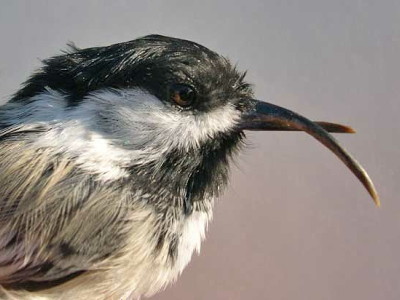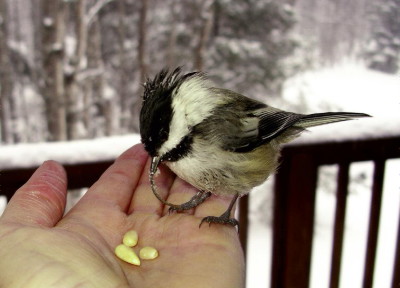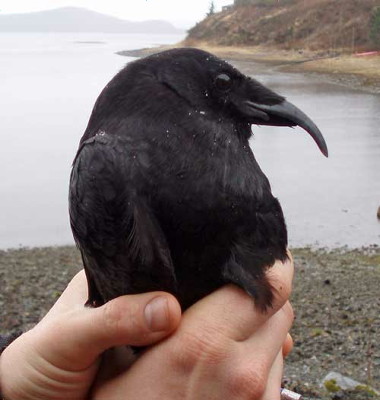Is it caused by pollution? The mystery of deformity of the bird's beak growing rapidly in Alaska

American Geological SurveyAccording to the report, from the late 1990's in AlaskaBeakCurls oddly and intersects the upper and lower beakMalformationIt seems that many birds are being observed.
Such deformed birds are in AlaskaAmerican KogaraAnd more than 30 species, including abnormalities, have been confirmed at an abnormally high rate, the occurrence area is CanadaYukon TerritoryYaBritish Columbia, In the mainland of the United StatesState of WashingtonIt is said that it is expanding to.
There seems to be some investigation suggesting that the pollutant is caused, but further investigation is necessary to investigate the cause, and the American Geological Survey Office is calling for wild bird lovers to cooperate.
Details are as below.Alaska Science Center - Beak Deformities
healthyAmerican Kogara.

BeakkeratinThe layer is abnormally developed and curled American cogala.

Here the beak grows up and down, completely intersecting.

The malformation has been confirmed in over 2100 individuals so far, and the expression rate is estimated to be about 6.5% in adults. This has beenSparrow eyesIt is more than four times the record of the highest abnormality rate confirmed in the group of. The abnormal development of the beak of the wild bird is less than 0.5% in the usual group.

In addition to abnormality of beaked beaks, there are also cases where abnormality is seen in skin, legs, feet, nails, wings, and the like. Because malformed individuals have difficulty in eating food, the time it takes for them to stay at the escalators and dumping grounds prepared by humans becomes longer, and the risk that can be caught by the predators becomes higher accordingly. It also makes it difficult to keep the hair growing, making it difficult to keep your body temperature during the winter and increasing the death rate. It is difficult to warm the eggs during the breeding season, take the fat after the chicks return, take care of the grooming etc, so in the nest where one or both of the parent birds have abnormality in beaked beefsteak It seems that the proportion of chicks and the proportion of nesting are decreasing.

A crow that inhabits from the south coast of Alaska, the west bank of Canada to the state of WashingtonNorthwestern Crow (Himekobashi Glass)But abnormal development of beaked bees was seen,Approximately 17% of adults are malformationsIt is seen. This is the highest rate in history as a percentage of birth defects confirmed in wild birds.

Although environmental contamination, nutrition, diseases, parasites, genetics, etc. can be considered as causes of malformation, evidence of abnormal development of beak as a symptom may be observed in the past investigations or evidence of liver diseases and parasites There was no evidence that this malformation was inherited.
Regarding environmental pollution, malformations in birds that eat fish around the Great Lakes that occurred in the 1970s are included in industrial wastewaterPCB (polychlorinated biphenyl)YaPCDD (polychlorinated dibenzodioxin),Such as PCDF (polychlorinated dibenzofuran)Organochlorine compoundThe waterbird malformations that occurred in California in the first half of the 1980s caused high concentrations of agricultural wastewaterseleniumI know that it was the cause. Therefore, we examined the presence or absence of various contaminants including metal elements, nonmetallic elements, organic pesticides, PCB, PCDD, PCDF in a wide range of samples such as healthy adult and deformed adult birds, eggs and chicks in American kogala in Alaska However, there is no evidence that an element such as selenium is the cause of a malformation, and it seems that the result suggesting that the organochlorine compound is the cause was obtained. In particular, the PCB was found commonly in eggs, chicks and adults of American coda, and it seems that correlation was found between the concentration and the deformity of beakberries and the decrease in hatching rate.
We also investigated pollutants such as agricultural chemicals contained in sunflower seeds commonly found in bait houses such as private houses, and found that the concentration of pollutants is low and the possibility that human feeds are a source of pollution is excluded It seems that it was done.
Including PCB in the futureDioxinsWe will further investigate, focusing on not only the American Kogara but also to investigate Kimbasi glass. Furthermore, nutritional conditions such as insufficiency of vitamin A and vitamin D 3, bias of the intake rate of calcium and phosphorus can also cause abnormal development of beaked bee, and malnutrition due to some reason also causes malformation due to pollutants We are planning to investigate this point as possibly involved.
Related Posts:
in Creature, Posted by darkhorse_log







